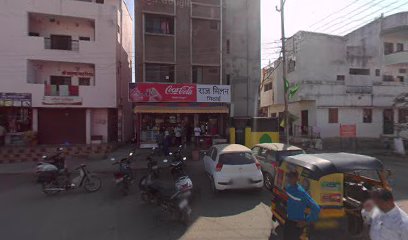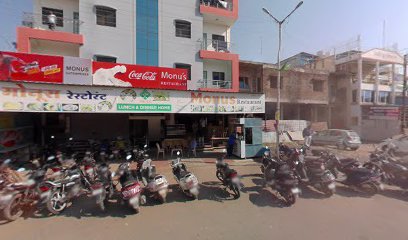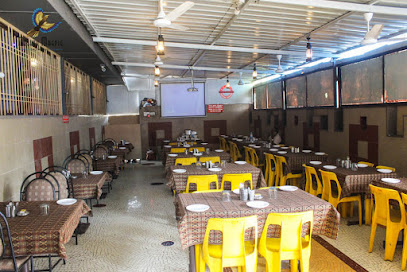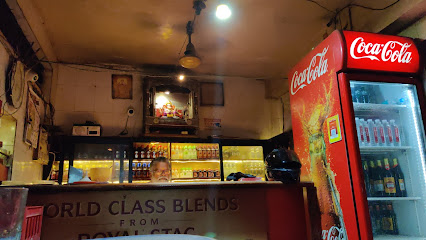
Begumpura: The Historic Jewel of Aurangabad
Explore Begumpura in Aurangabad: A blend of historic grandeur, vibrant markets, and cultural treasures that offer an authentic Indian experience.
Begumpura, nestled in the vibrant city of Aurangabad, is a neighbourhood rich with history and cultural significance. As you meander through its bustling streets, you'll find a unique blend of the old and the new, where centuries-old architecture stands juxtaposed with modern developments. The neighbourhood is particularly renowned for its proximity to the Bibi Ka Maqbara, often referred to as the 'Taj of the Deccan'. This stunning mausoleum, built in the 17th century by Emperor Aurangzeb in memory of his wife, is a must-visit for history buffs and architecture enthusiasts alike. Beyond its historical landmarks, Begumpura offers an authentic taste of local life. The vibrant markets are a sensory delight, filled with the sounds of haggling vendors, the aroma of street food, and a kaleidoscope of colourful textiles and handicrafts. Don't miss the opportunity to sample local delicacies like 'Naan Qalia', a traditional dish that reflects the rich culinary heritage of the region. For those interested in spiritual and religious sites, Begumpura is home to several ancient mosques and temples, each telling its own story of the region's diverse cultural tapestry. The serene environment of these places offers a peaceful respite from the bustling streets and provides a deeper understanding of the local way of life. In summary, Begumpura is a neighbourhood that promises an enriching experience for every kind of traveller. Its rich historical background, vibrant local culture, and welcoming atmosphere make it a quintessential stop on any Aurangabad itinerary.
Local tips in Begumpura
- Visit early in the morning to avoid crowds at Bibi Ka Maqbara.
- Wear comfortable shoes as the streets can be uneven and require a lot of walking.
- Try the local dish 'Naan Qalia' at a recommended eatery for an authentic taste.
- Carry cash, as many local vendors might not accept cards.
- Respect local customs and dress modestly, especially when visiting religious sites.
Begumpura: The Historic Jewel of Aurangabad
Begumpura, nestled in the vibrant city of Aurangabad, is a neighbourhood rich with history and cultural significance. As you meander through its bustling streets, you'll find a unique blend of the old and the new, where centuries-old architecture stands juxtaposed with modern developments. The neighbourhood is particularly renowned for its proximity to the Bibi Ka Maqbara, often referred to as the 'Taj of the Deccan'. This stunning mausoleum, built in the 17th century by Emperor Aurangzeb in memory of his wife, is a must-visit for history buffs and architecture enthusiasts alike. Beyond its historical landmarks, Begumpura offers an authentic taste of local life. The vibrant markets are a sensory delight, filled with the sounds of haggling vendors, the aroma of street food, and a kaleidoscope of colourful textiles and handicrafts. Don't miss the opportunity to sample local delicacies like 'Naan Qalia', a traditional dish that reflects the rich culinary heritage of the region. For those interested in spiritual and religious sites, Begumpura is home to several ancient mosques and temples, each telling its own story of the region's diverse cultural tapestry. The serene environment of these places offers a peaceful respite from the bustling streets and provides a deeper understanding of the local way of life. In summary, Begumpura is a neighbourhood that promises an enriching experience for every kind of traveller. Its rich historical background, vibrant local culture, and welcoming atmosphere make it a quintessential stop on any Aurangabad itinerary.
Iconic landmarks you can’t miss
BIBI KA MAQBARA
Discover the beauty of Bibi Ka Maqbara, a stunning Mughal mausoleum in Aurangabad, showcasing exquisite architecture and a romantic love story.

Delhi Gate
Discover the architectural splendor and historical significance of Delhi Gate, a must-see landmark in Aurangabad, Maharashtra.

Makai Gate
Discover Makai Gate in Aurangabad – a stunning historical landmark that showcases Mughal architecture and rich cultural heritage.

Soneri Mahal
Discover the architectural beauty and rich history of Soneri Mahal, a magnificent monument in Aurangabad, Maharashtra, reflecting India's glorious past.

History Museum
Explore Aurangabad's History Museum: A profound journey through the region's rich cultural heritage and historical treasures.

Navkhanda Palace
Explore Navkhanda Palace, a majestic historical landmark in Aurangabad reflecting Maharashtra's rich cultural heritage and architectural beauty.

Dr Babasaheb Ambedkar Statue
Explore the Dr. Babasaheb Ambedkar Statue in Aurangabad, a powerful tribute to social justice and equality amidst stunning surroundings.

Naubat Gate (Naubat Darwaza) (Quil-e-Ark)
Explore Aurangabad's Naubat Gate, a stunning historical landmark showcasing exquisite architecture and rich cultural heritage in Maharashtra.

Kham River Water Fall
Discover the tranquil beauty of Kham River Waterfall in Aurangabad, where cascading waters meet lush landscapes for an unforgettable nature escape.

Stepwell near Soneri Mahal
Discover the tranquil beauty of the stepwell near Soneri Mahal, a hidden architectural gem in Aurangabad, Maharashtra, rich in history and serenity.

Unmissable attractions to see
Essential places to dine
Great Sagar Restaurant
Discover the essence of Indian cuisine at Great Sagar Restaurant in Aurangabad – where every meal tells a story.

Monu's RESTAURANT
Discover authentic Indian flavors at Monu's Restaurant in Aurangabad—your go-to spot for breakfast and fast food delights.

Nanu's Pure Veg Restaurant
Savor authentic vegetarian delights at Nanu's Pure Veg Restaurant in Aurangabad - a must-visit for food enthusiasts.

Hotel Tiger hills
Experience comfort and culture at Hotel Tiger Hills in Aurangabad - your family-friendly gateway to Maharashtra's treasures.

Hotel Om Sai
Discover authentic Maharashtrian cuisine at Hotel Om Sai in Aurangabad—a culinary journey through local flavors awaits.

Smile Fast Food Center
Experience the vibrant flavors of Aurangabad at Smile Fast Food Center - your go-to spot for authentic Indian fast food.

PARI BHOJNALYA
Savor authentic Maharashtrian cuisine at Pari Bhojnalya in Aurangabad – where tradition meets flavor.

INDIAN CHINESE FAST FOOD CENTER
Experience a delightful blend of Indian and Chinese flavors at Aurangabad's popular fast food center.

Ravi Nasta Center
Discover authentic Maharashtrian cuisine at Ravi Nasta Center in Aurangabad, where every dish tells a story.

HOTEL PRITHVIRAJ FAMILY RESTAURANT
Experience authentic fast food at Hotel Prithviraj Family Restaurant in Aurangabad – where taste meets tradition in every bite.

Markets, malls and hidden boutiques
Shri Krishna Aai Emporium
Explore the essence of Aurangabad at Shri Krishna Aai Emporium—your one-stop destination for local crafts and treasures!

DILIP EMPORIUM
Discover unique souvenirs and local treasures at Dilip Emporium in Aurangabad, an essential stop for every traveler.

Vishal Store
Explore local goods and authentic culture at Vishal Store, the must-visit general store in Aurangabad's vibrant Begampura neighborhood.

Umesh Mohite Store
Explore Umesh Mohite Store in Aurangabad for unique local crafts and souvenirs near the iconic Taj Mahal.

SUJATA BAUTIQ
Explore the heart of Aurangabad at Sujata Bautiq, where local artistry and culture come together in a delightful shopping experience.

Jawale Store
Discover authentic local crafts and delicacies at Jawale Store, a cultural gem in Aurangabad, Maharashtra.

Shivam emporium
Explore the vibrant offerings of Shivam Emporium, a local treasure in Aurangabad, Maharashtra, where culture and shopping unite.

RASHIKA BANGLE'S STORE
Explore Rashika Bangle's Store for exquisite bangles and authentic local crafts in the heart of Aurangabad, Maharashtra.

Muktai Emporium
Explore Muktai Emporium for unique gifts, local crafts, and treasures that embody the spirit of Aurangabad.

Anuradha Store
Discover authentic local culture and unique handicrafts at Anuradha Store in Aurangabad, Maharashtra, a true treasure for every traveler.

Essential bars & hidden hideouts
Devpriya's Floating Spirit Bar And Restaurant
Discover a culinary oasis at Devpriya's Floating Spirit Bar And Restaurant, where vibrant flavors meet a stunning atmosphere in Aurangabad.

Hotel Janki
Discover Hotel Janki in Aurangabad - a vibrant bar and restaurant offering delicious food and drinks in a welcoming atmosphere.

Varad Restaurant& Beer Bar
Discover the vibrant flavors and lively atmosphere at Varad Restaurant & Beer Bar in Aurangabad, a perfect spot for food and drink lovers.

Harry's Bar
Discover the vibrant flavors and lively atmosphere at Harry's Bar in Aurangabad, the perfect locale for relaxation and culinary delight.

Amit Bar & Restaurant
Experience the vibrant ambiance and diverse menu at Amit Bar & Restaurant in Aurangabad for a memorable dining experience.

Samrat Bar
Discover the local nightlife at Samrat Bar in Aurangabad, where vibrant ambiance meets a diverse drink selection, perfect for socializing.

Shree Mangalam Wine Bar
Discover the delightful Shree Mangalam Wine Bar in Aurangabad, where wine lovers can enjoy an extensive selection in a cozy, inviting atmosphere.

Deshi Wine Shop
Discover a culinary delight at Deshi Wine Shop, a grill restaurant in Aurangabad offering exquisite flavors and a cozy atmosphere for an unforgettable dining experience.

Maharashtra Raswanti Hamkas
Discover the vibrant flavors of Maharashtra at Raswanti Hamkas, a lively bar in Aurangabad offering local drinks and snacks in a welcoming atmosphere.

Tease Bar
Experience the perfect blend of luxury, vibrant nightlife, and exquisite cuisine at Tease Bar in Aurangabad.

Local Phrases
-
- Helloनमस्कार
[namaskar] - Goodbyeअलविदा
[alvida] - Yesहाँ
[haan] - Noनहीं
[nahi] - Please/You're welcomeकृपया/स्वागत है
[krupaya/swagat hai] - Thank youधन्यवाद
[dhanyavaad] - Excuse me/Sorryक्षमा कीजिए/माफ़ कीजिए
[kshama keejiye/maaf keejiye] - How are you?आप कैसे हैं?
[aap kaise hain?] - Fine. And you?ठीक हूँ। और आप?
[thik hoon. aur aap?] - Do you speak English?क्या आप अंग्रेज़ी बोल सकते हैं?
[kya aap angrezi bol sakte hain?] - I don't understandमुझे समझ में नहीं आया
[mujhe samajh mein nahi aaya]
- Helloनमस्कार
-
- I'd like to see the menu, pleaseकृपया मेन्यू दिखाइए
[krupaya menyu dikhaiye] - I don't eat meatमैं मांस नहीं खाता/खाती
[main maans nahi khaata/khati] - Cheers!चियर्स!
[cheers!] - I would like to pay, pleaseकृपया मुझे भुगतान करने दीजिए
[krupaya mujhe bhugtan karne dijiye]
- I'd like to see the menu, pleaseकृपया मेन्यू दिखाइए
-
- Help!बचाओ!
[bachao!] - Go away!चले जाओ!
[chale jao!] - Call the Police!पुलिस को बुलाओ!
[police ko bulaao!] - Call a doctor!डॉक्टर को बुलाओ!
[doctor ko bulaao!] - I'm lostमैं खो गया/गई हूँ
[main kho gaya/gayi hoon] - I'm illमुझे बीमारी है
[mujhe bimari hai]
- Help!बचाओ!
-
- I'd like to buy...मैं ... खरीदना चाहूँगा/चाहूँगी
[main ... khareedna chahunga/chahungi] - I'm just lookingमैं बस देख रहा/रही हूँ
[main bas dekh raha/rahi hoon] - How much is it?यह कितने का है?
[yah kitne ka hai?] - That's too expensiveयह बहुत महंगा है
[yah bahut mahnga hai] - Can you lower the price?क्या आप कीमत कम कर सकते हैं?
[kya aap keemat kam kar sakte hain?]
- I'd like to buy...मैं ... खरीदना चाहूँगा/चाहूँगी
-
- What time is it?अभी कितने बजे हैं?
[abhi kitne baje hain?] - It's one o'clockएक बजे हैं
[ek baje hain] - Half past (10)दस बजे तक
[das baje tak] - Morningसुबह
[subah] - Afternoonदोपहर
[dopahar] - Eveningशाम
[shaam] - Yesterdayकल
[kal] - Todayआज
[aaj] - Tomorrowकल
[kal] - 1एक
[ek] - 2दो
[do] - 3तीन
[teen] - 4चार
[chaar] - 5पांच
[paanch] - 6छह
[chhe] - 7सात
[saat] - 8आठ
[aath] - 9नौ
[nau] - 10दस
[das]
- What time is it?अभी कितने बजे हैं?
-
- Where's a/the...?...कहाँ है?
[...kahan hai?] - What's the address?पता क्या है?
[pata kya hai?] - Can you show me (on the map)?क्या आप मुझे दिखा सकते हैं (नक्शे पर)?
[kya aap mujhe dikha sakte hain (nakshay par)?] - When's the next (bus)?अगली (बस) कब है?
[agli (bas) kab hai?] - A ticket (to ....)एक टिकट (.... के लिए)
[ek ticket (.... ke liye)]
- Where's a/the...?...कहाँ है?
History of Begumpura
-
Begumpura, meaning 'City of the Begum,' was established during the reign of the Mughal Emperor Aurangzeb in the late 17th century. The area was named in honor of his wife, Begum Zeb-un-Nissa, and served as an important cultural and administrative center in Aurangabad. The development of Begumpura coincided with the Mughal Empire's expansion in the Deccan region, and the neighborhood became a hub for trade and cultural exchange.
-
Begumpura is characterized by its unique architectural styles, blending Mughal and local influences. Notable structures include intricately designed mosques and tombs, reflecting the artistic legacy of the period. The area's buildings exhibit ornate carvings, elaborate frescoes, and expansive courtyards, which are testaments to the craftsmanship of the artisans who worked during the Mughal era.
-
During the Deccan Wars in the late 17th century and early 18th century, Begumpura played a strategic role due to its location. The neighborhood served as a military outpost and provided logistical support to the Mughal army. The battles fought in and around Aurangabad impacted the socio-political landscape, leading to a decline in the Mughal influence and the rise of regional powers.
-
Begumpura has historically been a melting pot of cultures, attracting people from various regions due to its trade routes and administrative significance. The neighborhood is known for its vibrant festivals, traditional music, and dance forms that reflect the diverse heritage of the region. This cultural amalgamation is evident in local cuisine, art, and community celebrations, making it a lively part of Aurangabad's cultural tapestry.
-
In recent decades, efforts have been made to preserve the historical and cultural significance of Begumpura amidst rapid urbanization. Local government and cultural organizations are working to maintain the architectural integrity of the neighborhood while promoting it as a tourist destination. Initiatives include heritage walks and cultural festivals that celebrate Begumpura's rich history and encourage community engagement.
Begumpura Essentials
-
Begumpura is well-connected to the rest of Aurangabad. The Aurangabad Railway Station is about 5 kilometers away, and from there, you can take a local taxi or auto-rickshaw to reach Begumpura. If you're coming from the Aurangabad Airport, which is approximately 10 kilometers away, taxis are available for hire. Public buses also operate from various parts of the city to Begumpura, making it accessible for budget travelers.
-
In Begumpura, the best way to get around is by using auto-rickshaws or local taxis, which are readily available. Public buses also serve the area, but they may not be as frequent. For those who prefer to explore on foot, many attractions are within walking distance. Bicycles can be rented from local shops, providing a unique way to explore the neighborhood.
-
Begumpura is generally safe for tourists, but it is important to take standard safety precautions. Avoid walking alone at night in less populated areas and keep your belongings secure in crowded places. Areas such as the outskirts of Begumpura, particularly near isolated parks, may have higher crime rates, so exercise caution when exploring these parts.
-
In case of an emergency, dial 100 for police assistance or 108 for ambulance services. There are local hospitals and clinics in Aurangabad that can provide medical care. It is advisable to have travel insurance that covers emergencies, and know the location of the nearest hospital from your accommodation.
-
Fashion: Do dress modestly, especially when visiting local temples or religious sites. Avoid wearing revealing clothing. Religion: Do respect local customs and traditions. Always remove your shoes before entering places of worship. Public Transport: Do give up your seat for elderly passengers. Don't eat or drink on public transport. Greetings: Do greet locals with a smile and a polite 'Namaste.' Don't engage in overly familiar behavior without invitation. Eating & Drinking: Do try local dishes and accept food offerings graciously. Don't refuse hospitality, as it can be seen as impolite.
-
To experience Begumpura like a local, visit the bustling street markets where you can sample street food and shop for handicrafts. Engage with the local community to learn about their culture and history. Visit the nearby heritage sites such as the Bibi Ka Maqbara, but also explore lesser-known spots to enjoy a more authentic experience. Early morning strolls can provide a peaceful way to observe daily life and local customs.
Nearby Cities to Begumpura
-
Things To Do in Nashik
-
Things To Do in Pune
-
Things To Do in Mumbai
-
Things To Do in Vadodara
-
Things To Do in Nagpur
-
Things To Do in Bhopal
-
Things To Do in Ahmedabad
-
Things To Do in Panaji
-
Things To Do in Goa
-
Things To Do in Rajkot
-
Things To Do in Udaipur
-
Things To Do in Jabalpur
-
Things To Do in Raipur
-
Things To Do in Ranthambore
-
Things To Do in Pushkar










